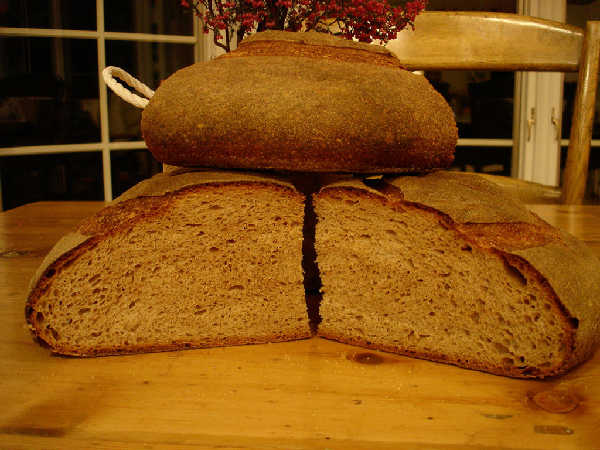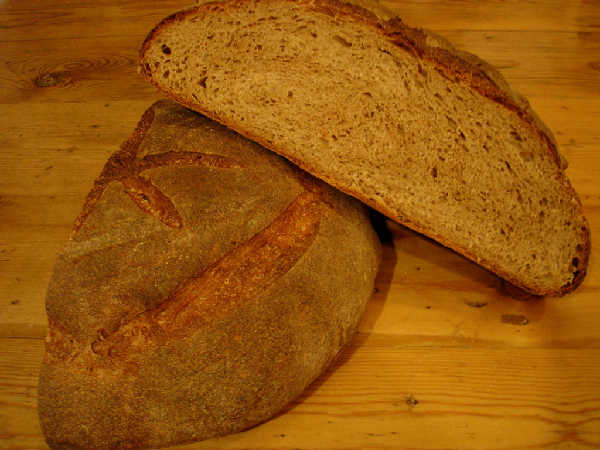My staple bread for the past couple of years has been a miche. I started doing the BBA recipe with half bread flour and half KA whole wheat flour. Lately I've been experimenting with different blends of organic and sifted flours. I haven't yet settled on one recipe and change things every time I do it lately, but I thought I'd describe this basic recipe.


Mixed-Flour Miche: Loosely based on BBA Miche and Hamelman Mixed-Flour Miche.
I have some photos of my process.
Many, many thanks to JMonkey, SourdoLady, Zolablue, Mountaindog, Floydm, and numerous others. My results on this and other recipes are much better because of the great ideas I've found in the various blogs, postings, and lessons here.
Mixed-Flour Miche: Loosely based on BBA Miche and Hamelman Mixed-Flour Miche.
There is a "firm starter" that is built from white poolish-like starter as in the BBA "barm" version (50/50 by weight using breadflour and water), which is retarded overnight and included in the dough which is baked the same day.
The recipe I've been doing lately has evolved from the BBA miche recipe to be more like the "Mixed-Flour Miche" in Bread by Hamelman. My objective has basically been to have a high whole wheat content, but use sifted flours to get a less coarse crumb. I have also mixed red wheat and white wheat flours as well as tried some spelt trying to come up with a flavor that is not too "grassy" or "nutty". I find the taste of 100% white wheat bread to be a little too bland, whereas using too much red wheat seems bitter in a way I don't like.
As a result, I've ended up mixing various flours in an attempt to get something that is mostly whole wheat with some of the coarser bran sifted out and partly red wheat, partly white wheat for flavor.
The recipe showing in the photos is as follows, and is loosely based on both the BBA Miche and the Hamelman "Mixed-Flour Miche" in Bread.
For the firm starter:
- 7oz "BBA style barm" (100% hydration bread flour starter)
- 6oz Golden Buffalo flour (sifted red wheat flour from Heartland Mills)
- 3 oz KA Organic Whole Wheat
- 4oz water
Mix/knead ingredients for about 3 minutes to get a fairly firm not very sticky dough. Place in container and let rise to about 1.5x in volume - about 3 hours. Punch it down and allow to rise again to double - another 2.5 hours, roughly. Place in refrigerator overnight. I was trying to get this one to be a little more sour, and I think I went too far, as the bread was just a touch too sour for my tastes, but I don't like my bread very sour. Some might like the more sour flavor I got. My plan is to reduce the rise time of the firm starter and use less Golden Buffalo and maybe use whole spelt flour in higher proportion next time.
For the dough:
- 6 oz KA whole spelt flour
- 8 oz Golden Buffalo sifted red wheat flour (Heartland Mills)
- 3 oz KA Organic Whole Wheat
- 6 oz sifted white wheat flour (Homestead Grist Mill)
- 6 oz Sir Lancelot High Gluten flour
- 3 oz KA Rye Blend
- 29 oz water
- 3/4 tsp diastatic malted barley flour
- 26 grams salt (about .9 oz)
- Firm starter from day before.
Cut up firm starter and cover with towel to allow the pieces to lose their chill.
Autolyse: Mix all but salt and starter in bowl until the ingredients form a uniform shaggy mass. Allow to rest for 60 minutes.
Mix and knead dough: Push the pieces of starter into the dough and sprinkle with salt. Mix/knead for 5 minutes to form a supple, fairly soft dough. The total hydration of the entire overall dough is 82%, so it is relatively soft at the beginning. Place in a container to rise.
Fold the dough hourly: The total bulk fermentation time was 4.5 hours. I think I probably went too long, though. Anyway, I was folding it using the technique in Hamelman's Bread, i.e. (very roughly) turn the dough out on a bed of flour top down and gently spread it out/push out some of the gas. Then pull out and stretch one side of the dough and fold it toward the center. Do the same for the other three sides. Put the dough back in the container with the top up and the seams down. I may have "overfolded", as the dough seemed a little "too tough" possibly, and I didn't get as much oven spring as I was hoping for.
Shape into boule: Form a boule not too differently from the folding technique above, except it is more of a gathering in of the edges of the dough and pinching them together to stretch the "top" of the dough (which is face down on the counter as with the folds). Flour a couche with rice flour and place in 8 quart steel mixing bowl, and then place the dough in the couche seams up.
Final Proof: Allow to rise for about 2.5 hours - again I let it go until 3 hours, and I think it was probably too long to wait.
Place on parchment: Place parchment on an upside down baking sheet or a peel and flour with coarse corn meal. Invert the bowl with the dough onto the parchment and pull away the bowl. Gently pull away the couche, which works great with the rice flour on the couche. Slash as photos show. I very lightly spray water on with spray mister.
Bake: Preheat oven to 500F well before this point, like an hour before. Use various steaming techniques as described many places for home ovens. Drop temperature to 450F after about 5 minutes. Bake at 450 for 10 minutes, then rotate loaf and drop temperature to 400F for another 20 minutes. Then rotate and drop temperature to 375F. Continue to bake until internal temperature is about 208F.
I would enjoy hearing any comments about how to manipulate flavor, the amount of rise, crumb texture, and so on. This bread did not rise quite as much as some others I've done in similar fashion. There are a few reasons I can think of, such as too much fermentation and proofing time, starter slightly too ripe and sour, possibly folding too much, maybe kneading too much in the very beginning, and so on. I also think the sour flavor is too much for my tastes, and other versions I've done were less sour. I think this is due mainly to overly long fermentation and proof, and to allowing the starter to become too ripe. Also, I used a higher proportion of red wheat flour in this starter than previously.